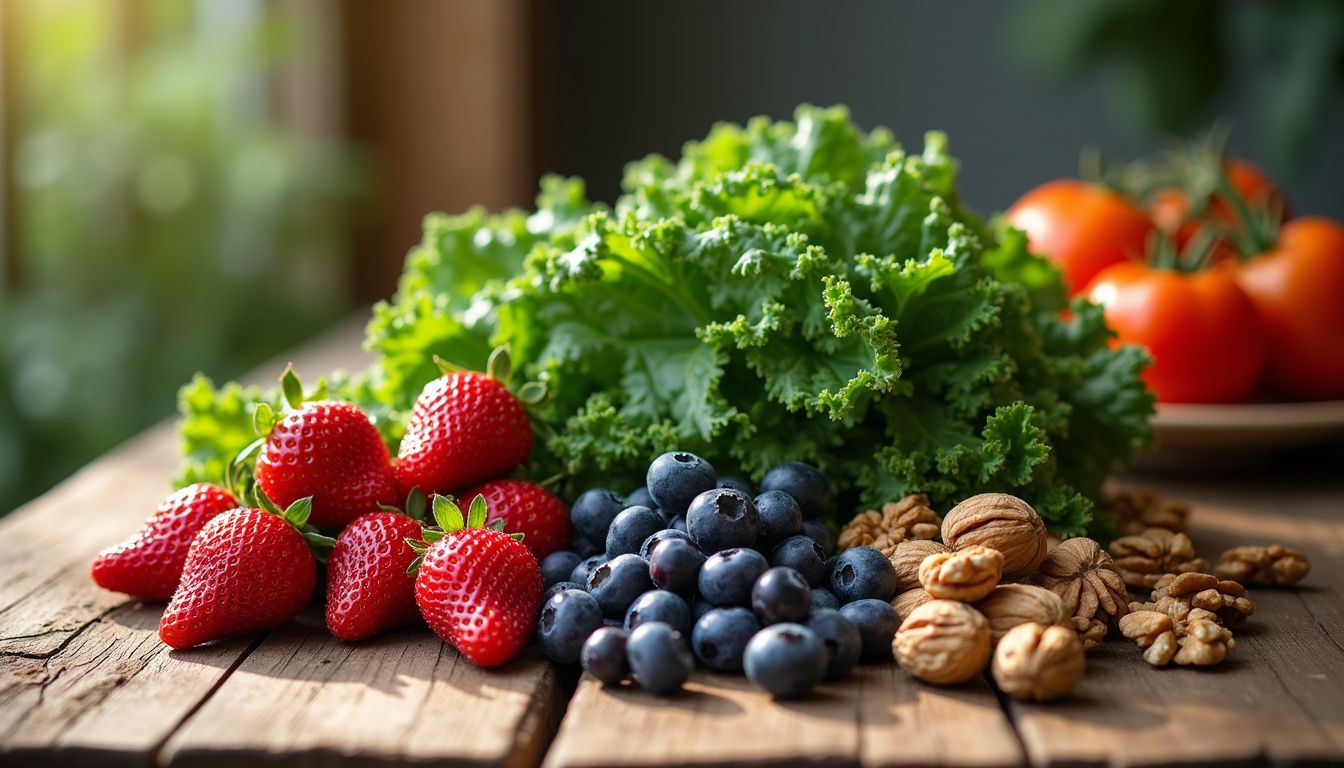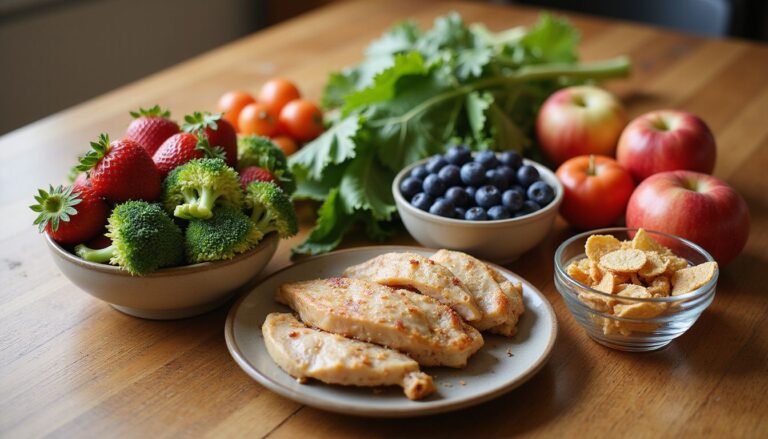Top Nutrient Dense Foods: Boost Your Health With Nutrient-Dense Food
Our Nutrition Assistant AI Suite will transform your body. You will lose fat, get toned, and build muscle. Gain confidence and optimal health.
I know the feeling of dragging through the day and scrambling to eat well. Choosing nutrient-dense foods helped me turn that around. These foods deliver more vitamins and minerals for every calorie than most packaged options.
In this guide, I highlight the healthiest picks, why they matter, and how to use them. You will see simple swaps, quick meals, and science-backed tips that fit a busy life. Keep reading to find the options that give the best bang for your buck.
Key Takeaways
- Nutrient-dense foods like salmon, kale, eggs, potatoes, and sardines supply many vitamins, minerals, healthy fats, and protein per calorie (AHA; FDA).
- Research links a nutrient-rich eating pattern with lower risk of heart disease and type 2 diabetes (PLOS Medicine 2016), better energy, and weight control.
- The American Heart Association suggests filling half your plate with fruits and vegetables to raise diet quality through antioxidants and dietary fiber.
- Salmon provides about 2.2 g omega-3s per 100 g. Dark chocolate at 70-85% cocoa offers iron and magnesium with less sugar than milk chocolate (Circulation 2005).
- Choosing whole grains such as oats or quinoa boosts fiber intake. Eggs at breakfast increase fullness more than sugary cereal or white toast.

What Does Nutrient Dense Mean?

Nutrient-dense means a food supplies many useful nutrients, like vitamins, minerals, and fiber, for relatively few calories. White bread and whole-grain bread have similar calories, yet whole-grain bread contains more protein, fiber, magnesium, potassium, vitamin B6, and zinc.
Fruits and vegetables shine because they are low in calories and high in antioxidants, which help protect cells, and dietary fiber, which supports digestion. The American Heart Association’s Heart-Check mark helps identify options that support heart health. The FDA defines low-calorie as 40 calories or fewer per serving, and meals at 120 calories or fewer per 100 grams.
I choose these foods to get the best value from each bite. They give the nutrients your body needs and help limit added sugar and saturated fat from highly processed foods.
What Are the Benefits of Eating Nutrient-Dense Foods?
Nutrient-dense foods provide more vitamins, minerals, and healthy fat for fewer calories. That means each meal works harder for your health and your energy.
How Do Nutrient-Dense Foods Improve Overall Health?
Meals rich in nutrient density help fight oxidative stress. Oxidative stress is cell damage caused by unstable molecules called free radicals. Lowering this stress supports a lower risk of chronic conditions such as cancer.
Plates built around fruits, vegetables, whole grains, lean meats, poultry, seafood like salmon or sardines, dairy products, and eggs support heart and digestive health. After I shifted toward more plant-based foods and fewer packaged snacks high in calories and low in micronutrients, my energy stayed steady.
The American Heart Association recommends filling half your plate with fruits and vegetables to build a balanced diet.
Whole grains supply B vitamins that aid energy use. Nuts add healthy fat that helps you feel full. Leafy greens like kale deliver vitamin C and other antioxidants that support the immune system. Choosing nutrient-dense options consistently gives better nutritional value than a standard American diet full of refined carbs and salty snacks.
Can Nutrient-Dense Foods Boost Energy Levels?
Yes. These foods provide steady fuel. I feel the difference when I pick whole grains such as oatmeal or barley instead of white bread or white rice. Oatmeal has about 71 calories per 100 grams and contains slow-digesting carbohydrate, which delivers longer-lasting energy than many boxed cereals.
A balanced breakfast sets up stable blood sugar and better focus. For example, 8 ounces of nonfat yogurt with half a cup each of papaya and kiwi, an ounce of walnuts, 8 ounces of coffee, and 4 ounces of skim milk stays under 250 calories yet supplies protein, healthy fats, and complex carbs. That mix supports muscle repair, satiety, and alertness without a mid-morning crash.
Do Nutrient-Dense Foods Enhance Immunity?
Many nutrient-dense foods support the immune system. Potatoes provide vitamin C, which helps the body’s defenses. Shellfish like clams supply vitamin C, potassium, selenium, and iron, key minerals for immune function.
Kale and other leaf vegetables provide vitamins A and C that help protect against infections. Berries, especially blueberries, are rich in anthocyanins and other polyphenols, plant compounds that may reduce inflammation and strengthen immune response.
Choosing a variety of nutrient-rich foods helps me meet daily micronutrient needs that keep immunity strong year-round.
How Do Nutrient-Dense Foods Help With Weight Management?
Nutrient-dense foods tend to be higher in fiber and protein, two factors that increase fullness. Lentils, chickpeas, and other beans help reduce hunger and support a lower calorie intake across the day.
For me, a breakfast with whole eggs makes appetite control easier. A 2021 study led by Agarwal S reported that adolescents who ate more potatoes had higher intakes of essential nutrients and better weight control. Potatoes contain resistant starch, a type of fiber-like carbohydrate that increases satiety.
Dark chocolate with 70-85 percent cocoa can support heart health and healthy blood pressure as part of an overall balanced plan. Choosing nutrient-dense foods helps meet vitamin and mineral needs while controlling calories, which supports a lower risk of obesity and common nutrient deficiencies seen in Western eating patterns.
Top Nutrient-Dense Foods to Include in Your Diet
Many foods deliver high nutrient density and fit into a healthy diet. I reach for options that improve energy, nutrient intake, and digestion with simple prep.
Why Is Salmon Good for You?
Salmon offers about 2.2 grams of omega-3 fatty acids and 25.4 grams of high-quality protein per 100 grams. It also contains vitamin B12, potassium, magnesium, and selenium, all important for heart, brain, and muscle function.
I pick salmon from sustainable sources. It is filling yet moderate in calories, and omega-3 fats support heart health and a lower risk of cardiovascular disease and stroke. Its B vitamins also support metabolism and nerve function for steady energy.
What Nutrients Do Sardines Provide?
Sardines are among the richest sources of omega-3s in commonly eaten fish. They provide complete protein and key nutrients, including vitamin D, vitamin B12, calcium from their soft bones, and selenium.
One 3-ounce serving supplies over half of the daily value for vitamin D and nearly double for vitamin B12. Sardines are lower in mercury than many larger fish. I eat them whole, including the edible bones and organs, to get the full nutrient package. Research links small fish intake with heart health and strong micronutrient coverage.
What Vitamins Are Found in Kale?
Kale is a standout among nutrient-dense vegetables. One cup has about 9 calories and delivers vitamin C, vitamin A as β-carotene, vitamin K, and vitamin B6. These support immunity, vision, blood clotting, and brain function.
Kale also provides calcium, potassium, fiber, and antioxidants such as lutein. Studies note cancer-fighting compounds in kale that support long-term health. I add it to salads and smoothies to raise vitamin intake without adding many calories.
How Does Seaweed Benefit Your Health?
Seaweed, such as nori sheets used for sushi, is rich in calcium, iron, magnesium, manganese, and iodine. I value seaweed for thyroid support because iodine helps regulate metabolism.
Antioxidants in seaweed help protect cells from damage linked to heart disease and stroke. About 10 grams of dried nori can provide up to 232 micrograms of iodine, which exceeds the daily need for most people. That makes seaweed a smart, nutrient-dense addition to a balanced diet.
Next, I explain how garlic can elevate both flavor and health in everyday meals.
What Are the Health Benefits of Garlic?
Garlic contains vitamins C, B1, and B6, plus minerals like calcium, potassium, copper, manganese, and selenium. It is rich in allicin, a sulfur compound that gives garlic its smell and many of its benefits.
People who include garlic regularly often show healthier blood pressure and cholesterol patterns in studies. Evidence suggests garlic may reduce total and LDL cholesterol, which supports heart disease prevention.
I cook with fresh cloves to add big flavor without extra calories or fat. Garlic pairs well with legumes such as chickpeas and lentils. If you enjoy seafood, the next section shows why shellfish deserve a spot on the plate.
Why Are Shellfish Nutrient Powerhouses?
Clams, oysters, scallops, and mussels pack many nutrients into a small calorie cost. Clams provide vitamin C, iron, potassium, and selenium. Oysters are famous for zinc. All are rich in vitamin B12.
About three ounces of cooked clams can deliver almost 100 percent of the daily value for vitamin B12 and more than 20 mg of iron. Mussels supply omega-3 fatty acids that support heart health. I choose shellfish from trusted, sustainable sources and stay mindful of local advisories for contaminants.
What Nutrients Make Potatoes Healthy?
Potatoes offer potassium for blood pressure control and muscle function. They also contain magnesium for bone health, iron to carry oxygen, copper and manganese for cell processes, and vitamin C for immunity. Most B vitamins appear in potatoes as well.
Keep the skin on to raise fiber. Baked or roasted potatoes make a better choice than French fries that are processed with extra oil. Thanks to resistant starch, potatoes are very filling, which helps me manage hunger while still keeping calories reasonable.
Why Is Liver Considered Nutrient-Dense?
Liver ranks near the top for nutrient density. A 3.5-ounce, or 100-gram, serving provides large amounts of vitamin B12 for nerves and red blood cells, along with B5, B6, niacin, folate, vitamin A, copper, iron for oxygen transport, phosphorus, zinc for immunity, selenium for cell protection, and complete protein.
Most experts suggest liver about once a week. I include chicken or beef liver to get these nutrients without overdoing any single vitamin or mineral. Its wide range of minerals makes liver a standout among foods in your diet.
How Do Berries Support Health?
Berries, such as blueberries, strawberries, and blackberries, are rich in antioxidants like anthocyanins and polyphenols. These compounds help protect cells from free radical damage.
Studies suggest berries may support brain function, healthy blood vessels, and lower risk of long-term disease. They also show anti-cancer activity in lab settings. A cup of strawberries or blackberries provides vitamin C with few calories, which helps with weight management. I stir berries into strained yogurt or oatmeal for fiber and natural sweetness.
What Makes Eggs a Complete Protein Source?
Eggs provide all nine essential amino acids, which the body cannot make, so they are a complete protein. One large egg delivers about 6 grams of protein plus healthy fats that help you feel full.
Many researchers call whole eggs nature’s multivitamin because they offer choline, lutein, zeaxanthin, vitamin D, and several B vitamins. Studies show an egg-based breakfast can support weight management due to high satiety. I rely on eggs for fast, nutrient-dense meals that do not break my calorie budget.
What Health Benefits Does Bitter Melon Offer?
One cooked cup of bitter melon, about 130 grams, contains only 53 calories yet delivers fiber, calcium, magnesium, potassium, B vitamins, vitamin K, vitamin C, and vitamin A. These nutrients support bone health, immunity, and energy production.
Research suggests bitter melon may aid blood sugar control and protect the brain from diseases such as Alzheimer’s. It may also carry anti-cancer properties. I like it in stir-fries with garlic or in soups for a nutrient boost that fits most eating plans.
Why Choose Dark Chocolate for Nutrients?
Dark chocolate at 70 to 85 percent cocoa contains iron, magnesium, copper, and manganese. Unsweetened cocoa powder is rich in antioxidants that support heart health.
Studies associate dark chocolate with lower blood pressure and improved cholesterol patterns. The American Heart Association advises enjoying chocolate for taste while keeping portions small. I add a square to oatmeal or bake with cocoa to get antioxidants with less added sugar than candy bars.
How Can You Add Nutrient-Dense Foods to Your Diet?
I look for simple upgrades that add flavor and nutrition. Olive oil, quinoa, and avocado are easy places to start.
How to Include More Fruits and Vegetables in Meals
Filling half your plate with fruits and vegetables is a strong first step. These ideas make it practical.
- Start meals with a salad using 1 cup dark lettuce, sliced peppers, 1 cup grape tomatoes, and 1/2 cup edamame, plus 1 tablespoon sunflower seeds.
- Add fresh berries or banana to Greek yogurt or oatmeal for fiber, antioxidants, and vitamin C.
- Fold colorful vegetables such as bell peppers or kale into omelets and stir-fries for more vitamins and minerals.
- Snack on raw veggie sticks with hummus. Carrots and bell peppers deliver nutrients with few calories.
- Swap white rice for whole grains like quinoa to raise protein, fiber, vitamins, and minerals.
- Mix chopped spinach or avocado into wraps or sandwiches for potassium and healthy fats.
- Choose fruit for dessert. A bowl of mixed berries offers antioxidants that support immunity.
- Roast potatoes or air-fry bitter melon to add new textures and nutrients to weekly meals.
- Serve a small side of kimchi or sauerkraut with vegetables at lunch to support gut health.
These steps raise daily intake of nutrients from plant-based foods without making your routine complicated.
Why Choose Whole Grains Over Refined Grains?
Replacing white bread, rice, and pasta with whole grains increases fiber, protein, magnesium, potassium, vitamin B6, and zinc. Refining removes the bran and germ, which takes away much of the nutrition.
Whole grains such as brown rice, oats, quinoa, barley, buckwheat, and wild rice offer steady energy and better satiety. When I switched from boxed cereal to oatmeal, I felt fuller longer and focused better at work. Studies also link whole grain intake with lower risk of type 2 diabetes due to higher magnesium and fiber.
How to Incorporate Healthy Fats Like Nuts and Seeds
Healthy fats from nuts and seeds make meals more satisfying and support heart health. They also add omega-3s, fiber, and plant protein.
- Snack on unsalted almonds, walnuts, or cashews instead of chips for a nutrient-dense bite.
- Add 1 ounce of walnuts, about 14 halves, to oatmeal for satiety and healthy fat.
- Sprinkle chia or flax over yogurt to boost omega-3s and fiber.
- Toss pumpkin seeds into salads for texture, protein, and magnesium.
- Blend a spoonful of sunflower seed butter into smoothies for a creamy texture with no added sugar.
- Top baked sweet potatoes with chopped pecans or hazelnuts to raise mineral intake.
- Pack a trail mix with unsalted nuts and seeds for balanced energy on the go.
Next, I share lean protein sources that fit easily into everyday meals.
What Are the Best Lean Protein Sources?
I reach for lean proteins that deliver nutrients without excess calories. Chicken breast from a rotisserie has around 122 calories per thick slice. Roasted turkey breast offers about 147 calories per 100 grams.
Cod provides about 84 calories per 100 grams and plenty of protein. For plant-based choices, cooked lentils at about 114 calories per 100 grams and edamame at about 140 calories per 100 grams are easy to add to salads or grain bowls. These options give the building blocks your body needs for strength and recovery.
What Are Some Nutrient-Dense Snack Ideas?
I aim for snacks that supply vitamin C and other key nutrients. Quick choices make it easier to stay on track during packed days.
How to Make Greek Yogurt with Berries
I like plain, low-fat Greek yogurt because it has about 73 calories per 100 grams and solid protein. I stir in strawberries and blackberries for antioxidants and vitamin C.
Half a cup of strawberries provides roughly 25 calories, and blackberries about 32 calories. Layering yogurt and berries creates a fast snack that delivers protein, fiber, and micronutrients without added sugar.
Why Choose Veggie Sticks with Hummus?
After yogurt with berries, I reach for veggie sticks with hummus for crunch. A cup of raw broccoli has about 31 calories, cauliflower about 27, and carrots are also low in calories, yet rich in nutrients.
Hummus adds plant protein and fiber. The combo keeps me full longer and supports steady energy between meals.
Are Hard-Boiled Eggs a Healthy Snack?
Sometimes I want a more filling snack that still fits a healthy plan. Hard-boiled eggs are a great choice. Each egg has high-quality protein, healthy fats, and choline for brain health.
One large egg contains about 6 grams of protein plus vitamins B12, D, A, and E, and minerals like iron and selenium. Lutein and zeaxanthin in the yolk support eye health. Eggs are portable, so I can bring them to work or school.
How to Enjoy Dark Chocolate with Almonds
Hard-boiled eggs cover protein, and dark chocolate with almonds adds minerals and crunch. I pick chocolate that is 70 to 85 percent cocoa for antioxidants and minerals like magnesium and iron.
Pair a square or two with unsalted almonds for healthy fats and extra protein. Studies link nuts with heart health and steady energy. I often break a small bar and mix it with ten to twelve whole almonds to keep portions in check. This snack hits the sweet spot without too much sugar or sodium.
[1] U.S. Department of Agriculture, FoodData Central, “Almonds, raw,” ndb.nal.usda.gov
How to Create Balanced, Nutrient-Dense Meals
I build meals from whole foods across the major food groups. That approach covers daily needs without complicated tracking.
How to Combine Proteins, Healthy Fats, and Carbs
Balanced plates include protein, healthy fats, and complex carbs. Each plays a role in energy, growth, and repair.
- Choose lean protein such as eggs or Greek yogurt. A breakfast with nonfat yogurt provides high-quality protein and calcium under 250 calories.
- Include healthy fats like walnuts or olive oil for satiety and heart support. I often add walnuts to yogurt or use olive oil on salad.
- Select complex carbs from whole grains, potatoes, or fruit for steady energy. A whole-wheat pita at lunch adds fuel and fiber.
- Combine all three at meals. A green salad with olive oil stuffed into a whole-wheat pita covers protein, healthy fats, and carbs.
- Use colorful fruits like papaya and kiwi for natural vitamins, antioxidants, and fiber.
- Add nutrient-dense sides such as salads topped with seeds or nuts to raise both flavor and nutrition.
- Enjoy coffee with skim milk for added calcium and low-fat protein while keeping calories in check.
Tips for Using Nutrient-Dense Ingredients in Recipes
Small swaps can turn everyday dishes into meals with higher nutrition. I keep the changes simple and repeatable.
- Load soups, stews, and stir-fries with extra vegetables instead of more meat or cheese to raise fiber and vitamins.
- Swap white rice or regular pasta for brown rice, quinoa, or whole wheat pasta to increase minerals and B vitamins.
- Use Greek yogurt or low-fat dairy for creamy sauces and dressings to cut saturated fat and raise protein.
- Add leafy greens like kale or spinach to omelets, salads, or smoothies to increase vitamin K, vitamin C, and antioxidants.
- Top dishes with nuts or seeds such as almonds or chia for magnesium, healthy fats, and plant protein.
- Bake potatoes with the skin on, since most of the potassium and fiber sit in the outer layer.
- Choose salmon or beans instead of processed meats to raise omega-3s and keep sodium lower.
- Season with garlic and fresh herbs. They add flavor and compounds like allicin that may support immune health.
- Pick dark chocolate, at least 70% cocoa, for dessert to gain antioxidants with less sugar than milk chocolate.
These habits make meals more satisfying and nutrient dense without extra work.
Frequently Asked Questions About Nutrient-Dense Foods
I answer common questions to help you shop and cook with confidence.
Which Food Is the Most Nutrient-Dense?
No single food sits at the top in every category. Oily fish, leafy greens, eggs, and potatoes all score well. Potatoes support energy and some nutrients, but they cannot cover every need alone.
Salmon offers omega-3 fatty acids, and kale provides vitamins A, C, and K. Shellfish such as oysters deliver iron and zinc at high levels per gram. I include these foods each week to get a broad mix of nutrients without relying on supplements.
Can Nutrient-Dense Foods Help With Weight Loss?
Yes. Eating nutrient-dense foods like eggs at breakfast can increase fullness and support weight loss, as reported by Keogh JB and colleagues in 2020. Berries and dark chocolate may help control hunger through effects on metabolism and satiety.
Switching my breakfast to eggs helped me feel full longer than cereal or toast. Fiber, protein, and key micronutrients keep you satisfied between meals, which can lower calories without feeling deprived.
What Is One Food You Can Survive On?
No single food can meet all needs long term. Dates and potatoes come close but still miss essential nutrients. Potatoes supply vitamin C and potassium, yet lack vitamin B12 and enough fat. Dates offer sugars and fiber but fall short on protein and essential fats.
People sometimes point to the potato as a near-complete food. In 2010, Chris Voigt ate only potatoes for 60 days with added salt for iodine to showcase their nutrition. Doctors do not advise this approach for long-term health. I feel and perform best with balanced meals that include a variety of nutrient-dense foods.
Conclusion
Choosing nutrient-dense foods gives my body the vitamins, minerals, and healthy fats it needs to thrive. Salmon, kale, berries, eggs, and potatoes make smart anchors for meals and snacks. Research links these choices with better heart health, steadier energy, and improved weight management [1][2]. I keep a mix on hand so every plate supports both mind and body.
This information is educational and not a substitute for medical advice. If you have a health condition or take medications, talk with a qualified healthcare professional about diet changes.
[1] Mozaffarian D., et al., “Cardiovascular benefits of nutrients in fish oils,” Circulation (2005).
[2] Satija A., et al., “Plant-based diets and risk of type 2 diabetes,” PLOS Medicine (2016).
FAQs
1. What are nutrient-dense foods and why do they matter for health?
Nutrient-dense foods provide high levels of vitamins, minerals, and other nutrients with relatively few calories. These foods support growth, energy, and immune function. For example, leafy greens like spinach or kale offer iron and vitamin K while being low in calories. Studies show that eating more nutrient-rich options can lower the risk of chronic diseases such as heart disease or diabetes (Harvard T.H. Chan School of Public Health).
2. Which top nutrient-dense foods should I include in my diet?
Include dark green vegetables like collard greens; fatty fish such as salmon; eggs; beans; nuts including almonds; berries like blueberries; seeds such as chia seeds; sweet potatoes; citrus fruits including oranges; and lean meats like turkey breast. Each food supplies a unique mix of essential nutrients.
3. How do I know if a food is truly nutrient dense?
Check nutrition labels for high amounts of protein, fiber, vitamins A or C, calcium, potassium, magnesium or folate per serving compared to its calorie content. Foods with less added sugar or sodium tend to be more nutritious choices.
4. Can you share a personal tip for adding more nutrient-dense foods into daily meals?
I started preparing salads using baby spinach mixed with grilled chicken strips and sunflower seeds at lunch each day last year after reading about their benefits in a medical journal article from Mayo Clinic Proceedings (2020). This simple change helped me feel fuller longer during work hours while boosting my intake of key nutrients.
Summary: Nutrient-dense foods deliver many important vitamins and minerals without excess calories or additives. Choosing these items regularly supports better health outcomes according to scientific research.







